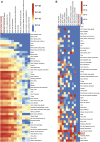Systematic Exploration in Tissue-Pathway Associations of Complex Traits Using Comprehensive eQTLs Catalog
- PMID: 34805976
- PMCID: PMC8595594
- DOI: 10.3389/fdata.2021.719737
Systematic Exploration in Tissue-Pathway Associations of Complex Traits Using Comprehensive eQTLs Catalog
Abstract
The collection of expression quantitative trait loci (eQTLs) is an important resource to study complex traits through understanding where and how transcriptional regulations are controlled by genetic variations in the non-coding regions of the genome. Previous studies have focused on associating eQTLs with traits to identify the roles of trait-related eQTLs and their corresponding target genes involved in trait determination. Since most genes function as a part of pathways in a systematic manner, it is crucial to explore the pathways' involvements in complex traits to test potentially novel hypotheses and to reveal underlying mechanisms of disease pathogenesis. In this study, we expanded and applied loci2path software to perform large-scale eQTLs enrichment [i.e., eQTLs' target genes (eGenes) enrichment] analysis at pathway level to identify the tissue-specific enriched pathways within trait-related genomic intervals. By utilizing 13,791,909 eQTLs cataloged in the Genotype-Tissue Expression (GTEx) V8 data for 49 tissue types, 2,893 pathway sets reported from MSigDB, and query regions derived from the Phenotype-Genotype Integrator (PheGenI) catalog, we identified intriguing biological pathways that are likely to be involved in ten traits [Alzheimer's disease (AD), body mass index, Parkinson's disease (PD), schizophrenia, amyotrophic lateral sclerosis, non-small cell lung cancer (NSCLC), stroke, blood pressure, autism spectrum disorder, and myocardial infarction]. Furthermore, we extracted the most significant pathways for AD, such as BioCarta D4-GDI pathway and WikiPathways sulfation biotransformation reaction and viral acute myocarditis pathways, to study specific genes within pathways. Our data presented new hypotheses in AD pathogenesis supported by previous studies, like the increased level of caspase-3 in the amygdala that cleaves GDP dissociation inhibitor and binds to beta-amyloid, leading to increased apoptosis and neuronal loss. Our findings also revealed potential pathogenesis mechanisms for PD, schizophrenia, NSCLC, blood pressure, autism spectrum disorder, and myocardial infarction, which were consistent with past studies. Our results indicated that loci2path's eQTLs enrichment test was valuable in unveiling novel biological mechanisms of complex traits. The discovered mechanisms of disease pathogenesis and traits require further in-depth analysis and experimental validation.
Keywords: complex traits; eQTLs; gene pathway sets; gene set enrichment analyses; tissue-pathway association.
Copyright © 2021 Wang, Yang, Qiu, Bai and Qin.
Conflict of interest statement
The authors declare that the research was conducted in the absence of any commercial or financial relationships that could be construed as a potential conflict of interest.
Figures



Similar articles
-
Regulatory annotation of genomic intervals based on tissue-specific expression QTLs.Bioinformatics. 2020 Feb 1;36(3):690-697. doi: 10.1093/bioinformatics/btz669. Bioinformatics. 2020. PMID: 31504167 Free PMC article.
-
Dissecting the genetics of the human transcriptome identifies novel trait-related trans-eQTLs and corroborates the regulatory relevance of non-protein coding loci†.Hum Mol Genet. 2015 Aug 15;24(16):4746-63. doi: 10.1093/hmg/ddv194. Epub 2015 May 27. Hum Mol Genet. 2015. PMID: 26019233 Free PMC article. Clinical Trial.
-
Applying meta-analysis to genotype-tissue expression data from multiple tissues to identify eQTLs and increase the number of eGenes.Bioinformatics. 2017 Jul 15;33(14):i67-i74. doi: 10.1093/bioinformatics/btx227. Bioinformatics. 2017. PMID: 28881962 Free PMC article.
-
Airway Epithelial Expression Quantitative Trait Loci Reveal Genes Underlying Asthma and Other Airway Diseases.Am J Respir Cell Mol Biol. 2016 Feb;54(2):177-87. doi: 10.1165/rcmb.2014-0381OC. Am J Respir Cell Mol Biol. 2016. PMID: 26102239 Free PMC article.
-
Determining causality and consequence of expression quantitative trait loci.Hum Genet. 2014 Jun;133(6):727-35. doi: 10.1007/s00439-014-1446-0. Epub 2014 Apr 26. Hum Genet. 2014. PMID: 24770875 Free PMC article. Review.
Cited by
-
gsQTL: Associating genetic risk variants with gene sets by exploiting their shared variability.bioRxiv [Preprint]. 2024 Sep 16:2024.09.13.612853. doi: 10.1101/2024.09.13.612853. bioRxiv. 2024. PMID: 39345521 Free PMC article. Preprint.
References
-
- Acar G., Akcay A., Sokmen A., Ozkaya M., Guler E., Sokmen G., et al. (2009). Assessment of Atrial Electromechanical Delay, Diastolic Functions, and Left Atrial Mechanical Functions in Patients with Type 1 Diabetes Mellitus. J. Am. Soc. Echocardiography 22 (6), 732–738. 10.1016/j.echo.2009.03.028 - DOI - PubMed
-
- Andreassen O. A., Harbo H. F., Harbo H. F., Wang Y., Thompson W. K., Schork A. J., et al. (2015). Genetic Pleiotropy between Multiple Sclerosis and Schizophrenia but Not Bipolar Disorder: Differential Involvement of Immune-Related Gene Loci. Mol. Psychiatry 20 (2), 207–214. 10.1038/mp.2013.195 - DOI - PMC - PubMed
LinkOut - more resources
Full Text Sources
Research Materials
Miscellaneous

